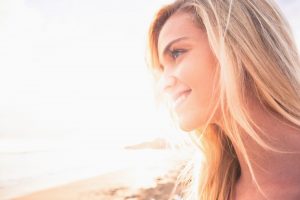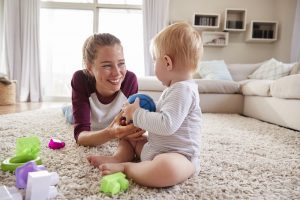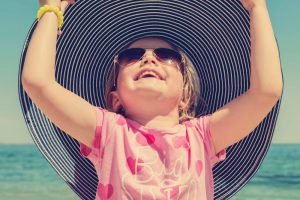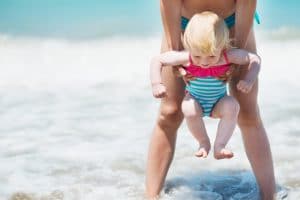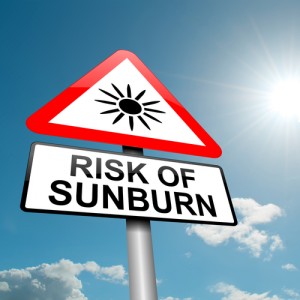
Many of us enjoy taking our babies outside and to the beach. In Australia, with such high rates of skin cancer, sun protection is obviously very important. A baby’s skin doesn’t contain much melanin –the pigment that gives our skin its colour and provides a bit of protection from the sun, so they tend to burn very easily. One risk factor for melanoma, the most deadly of all skin cancers is sunburn in childhood – so babies should not be getting burnt. The Cancer Council recommends that babies under one are not exposed to direct sunlight – although in Australia this is much easier said than done!
Depending on what you read, sunscreen is often not recommended for babies under six months of age. This is because it has been thought that possibly chemicals from sunscreen may be absorbed via the skin. However, researchers looking into whether sunscreen causes harm to babies have concluded that small amounts on uncovered areas of skin (such as face/hands) is ok. Obviously it is best to have as much physical cover (hats, long sleeves, shade) as possible but for the bits not covered a little sunscreen is fine – and better than the alternative of sunburn. The Australian College of Dermatologists recommend sunscreens be used at any age when exposed to the sun and the American Academy of Paediatrics agree – saying that small amounts of sunscreen can be used on babies under six months if clothing/shade is not available.
Here are some tips for protecting your baby from the sun & enjoying our summer safely:
- If UV levels are low (UV index <3) small amount of sun exposure is considered safe. If you are spending longer periods outside even if the UV factor is low you should protect your baby from the sun –ideally with shade/clothes but sunscreen as well if required.
- There is a free app available -(http://www.sunsmart.com.au/tools/interactive-tools/free-sunsmart-app) which lets you know the UV index at any time of the day wherever you are in Australia
- As a general guide you want to avoid sun between 10am and 3-4pm which is when the UV index is highest
- Always wear a hat (broad brimmed hats can reduce UV exposure to the eyes by up to 50% and offer good protection for the whole face, ears and neck)
- Keep in the shade (and keep checking your position as the sun and therefore shade moves)
- Remember, that even if you are in the shade, the UV can reflect off water/sand/concrete so you still need protective clothing/hats/sunscreen
- Use sunshades in the car
- Consider sun exposure in your pram – check how far down the hood can be adjusted and think about a pram sun cover. Things like muslin wraps over the pram block out a little sun (and are probably ok for early morning walks) – but if you hold it up to the sun/light and can see through it pretty easily it probably hasn’t got a very high UV rating!
- Consider sunglasses –check that they meet Australian standards (AS/NZS 1067) and have an EPF of 10. Note that fashion/toy sunglasses often don’t meet these standards.
What to look for in a sunscreen for baby
- There are a lot of “baby”/”infant” sunscreens out there – generally these tend to be more appropriate for sensitive skin but also have good protection
- Look for SPF 30 and water resistant if possible
- Generally sunscreens with reflective particles like zinc or titanium are the most protective (they provide a “physical” barrier from the sun rather than a chemical barrier). They are likely to be also less irritating to the skin as well.
- Try to find alcohol free sunscreens
- Test a bit on a small amount of skin first – to make sure your baby doesn’t have a reaction
- Always re-apply after swimming/sweating/toweling and every 2 hours
- Ideally apply 20-30mins before going into the sun
- Apply liberally! Most of us don’t apply enough
- Remember sunscreen does not offer 100% protection from the sun
What about vitamin D for baby?
Vitamin D (important for strong bones) is produced when our skin comes into contact with the sun. Talk to your doctor about this, but in Australia (where we have a lot of sunlight hours and high UV) most babies would make adequate vitamin D from reflected light.
Final advice for a sunsmart baby
Clothing/hats and shade (along with sunscreen as needed) are the most effective ways to keep your baby safe from the sun and reduce their risk of developing skin cancer in the future. And remember – role model! Children tend to copy their parents so if you are setting a good example with sunscreen, hat, protective clothes and sunglasses, your kids will probably follow suit! We know lots of baby’s won’t keep their hat on, so read our communities advice and tips.
Children who have been in the sun are at risk of dehydration, keep up the fluid and again avoid sun exposure where possible. Read more about dehydration in baby here

